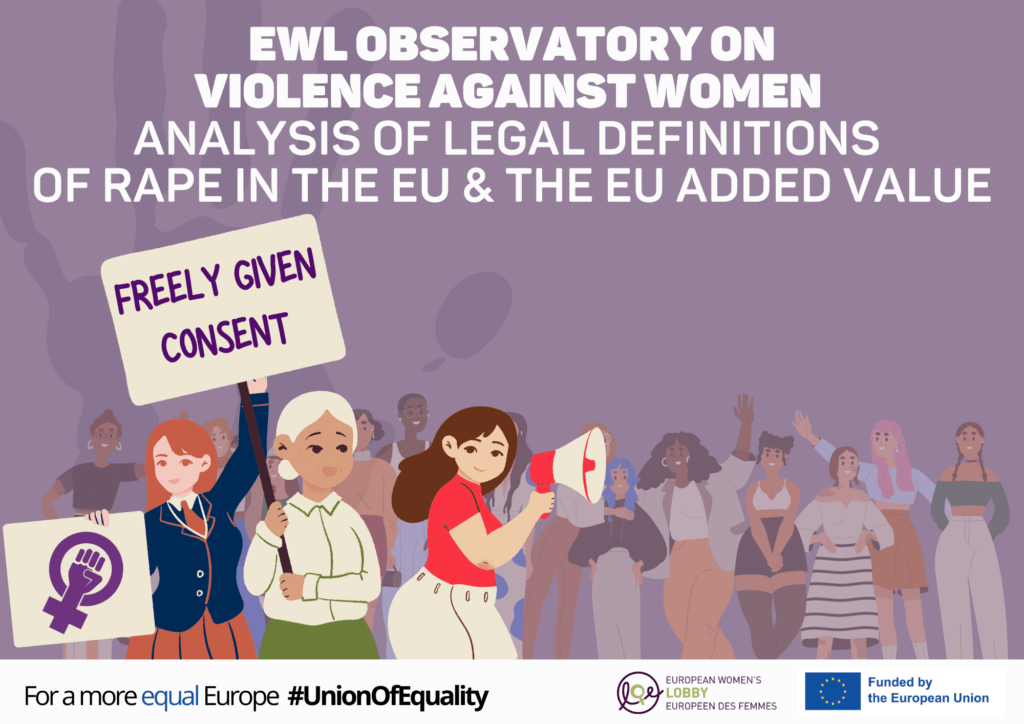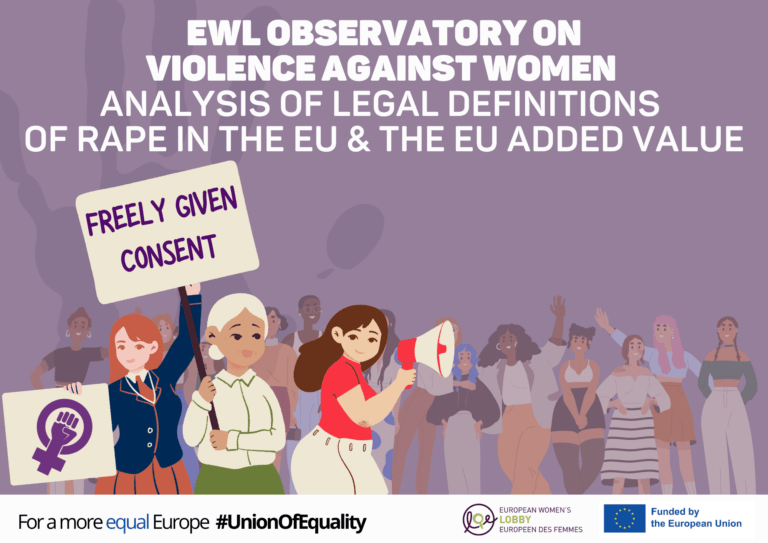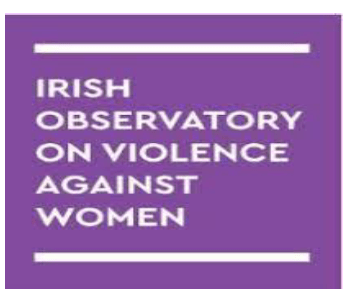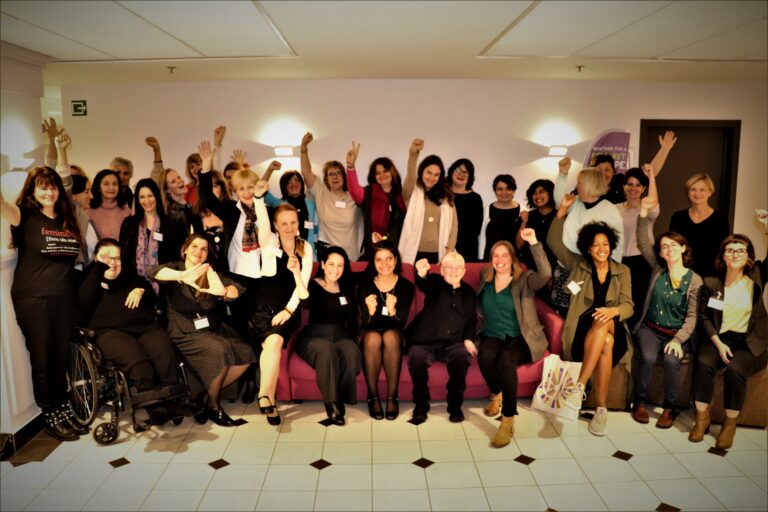Women victims of rape deserve to receive adequate access to justice and reparation everywhere in the EU, no matter where they live, where they work or where they travel.
Introduction
Rape is one of the most persuasive and brutal forms of violence against women and girls [[From all the incidents of violent sexual crimes recorded by Eurostat, more than 90% of the victims were women and 99% of the persons convicted were men. Eurostat, 2017]]: a crime against humanity that is at the very core of the violation of women’s fundamental rights. According to the results of the largest survey carried out in the EU and published almost ten years ago, one in 10 women has experienced some form of sexual violence since the age of 15, and one in 20 women has been raped [by the use of force] since the age of 15 [[Source: European Union Agency for Fundamental Rights (FRA), Violence against women: an EU-wide survey. Main results report, 2014]]. These crimes of sexual violence do not happen in isolation: “rape is rooted in patriarchal beliefs, entitlement, power and male domination, all of which foster an environment in which it is rampant and normalized” [[UN Special Rapporteur on violence against women (2020), “Report on rape as a grave and systematic human rights violation and gender-based violence against women”]]. The crime of rape lies on the continuum of male violence against women and must be viewed within a larger context. This includes gendered myths and stereotypes [[Special Eurobarometer N 449 on gender based violence: For example, almost 1 in 2 (47%) Maltese think that women often make up or exaggerate claims of abuse or rape. More than 1 in 2 persons (55%) in Romania believe that having sexual intercourse without sexual consent can be justified in certain situations such as being drunk or wearing revealing clothing. Here: https://publications.europa.eu/resource/cellar/f60437fd-e9db-11e6-ad7c-01aa75ed71a1.0001.01/DOC_1]] about male and female sexuality and sexual behaviour are still prevalent in the European societies; the objectification, pornification and commodification of women and girls. All these attitudes expose a rape culture which, coupled with the global consumerism, fosters sexual violence/sexual exploitation. Sexual violence remains heavily underestimated and undermined as the great majority of sexual crimes remain undisclosed. Women’s organisations have been alerting for years that these shocking figures are not enough to give us the full picture. In reality, the situation is much worse and the consequences of these forms of violence in the everyday life of the survivors are devastating and cannot be put into figures (See here survivor’s testimonies). Today, in the EU, only a small number of women feel safe to report and ask for help (10% of them in countries like France or Finland[[See GREVIO’s baseline evaluation reports on Finland, paragraph 198; and France, paragraph 219]]). The road “from report to court”[[Borrowing the title of the following report: Hester, M 2013, ‘From Report to Court: Rape and the Criminal Justice System in the North East’. Bristol: University of Bristol]] is paved with severe obstacles for women’s access to justice. There are high attrition rates (high number of cases fail to proceed through the investigation and prosecution stages)[[Council of Europe (2023): 4th General Report on GREVIO’s Activities. Covering the period from January to December 2022. Available here: https://rm.coe.int/4th-general-report-on-grevio-s-activities/1680aca199]] and there are also high levels of cases where the victim drops out and does not proceed any further. Many reported rapes are never prosecuted and, even worse, from those that are prosecuted, the vast majority do not end in a conviction. This reinforce women’s lack of trust of in the system; low reporting rates and perpetuates “a culture of impunity, leading to the normalisation of sexual violence, including rape”.Summary
The European Women’s Lobby (EWL) has developed an analysis of the definitions of rape in all EU Member States to assess compliance with the provisions in Artilce 36[[Article 36 of the Istanbul Convention. Sexual violence, including rape: “1. Parties shall take the necessary legislative or other measures to ensure that the following intentional conducts are criminalised: a) engaging in non-consensual vaginal, anal or oral penetration of a sexual nature of the body of another person with any bodily part or object; b) engaging in other non-consensual acts of a sexual nature with a person; c) causing another person to engage in non-consensual acts of a sexual nature with a third person”. “ 2. Consent must be given voluntarily as the result of the person’s free will assessed in the context of the surrounding circumstances”.]] addressing sexual violence, including rape of the Council of Europe Convention on preventing and combating violence against women and domestic violence, the Istanbul Convention, to which the EU is a party since 1 of October this year.
Detailed analysis
The EWL Observatory on violence against women has developed an analysis[[Key sources of information used for the analysis: – GREVIO evaluation reports and Alternative reports to GREVIO by women’s organisations and EWL members. – GREVIO Fourth general report on GREVIO’s activities (coe.int) – European Commission LexUriServ.do (europa.eu) – European Commission, Directorate-General for Justice and Consumers, Sosa, L., De Vido, S., Criminalisation of gender-based violence against women in European states, including ICT-facilitated violence : a special report, Publications Office, 2021, https://data.europa.eu/doi/10.2838/960650]] of the definitions on rape in all EU member states assessing their compliance with the standards of the Council of Europe Convention on preventing and combating violence against women and domestic violence, the Istanbul Convention, article 36[[Article 36 of the Istanbul Convention. Sexual violence, including rape: “1. Parties shall take the necessary legislative or other measures to ensure that the following intentional conducts are criminalised: a) engaging in non-consensual vaginal, anal or oral penetration of a sexual nature of the body of another person with any bodily part or object; b) engaging in other non-consensual acts of a sexual nature with a person; c) causing another person to engage in non-consensual acts of a sexual nature with a third person”. “ 2. Consent must be given voluntarily as the result of the person’s free will assessed in the context of the surrounding circumstances”]]. The analysis takes into account the recommendations and evaluations made by the Group of Experts on Action against Violence against Women and Domestic Violence (GREVIO) and the EWL Charter of principles on violence against women.Forced-based legislations
There are 11 EU Member States that still retain definitions on rape based on the use of force, coercion or threat: Bulgaria, Czech Republic, Estonia, France, Hungary, Italy, Latvia, Lithuania, Poland, Romania and Slovakia. According to the European Court of Human RIghts (ECHR) definitions based on the use of force as the main constituent element of the crime offer inadequate protection to victims of sexual violence and jeopardise the effective protection of the individual’s sexual autonomy[[M.C. v Bulgaria (Application No. 39272/98), judgment of 4 December 2003.]]. These definitions do not meet the standards of the Istanbul Convention that establishes that non-consensual acts of sexual nature should be criminalised. In countries like Lithuania, marital rape or rape that happens in the context of a relationship is not considered and in force. According GREVIO latest analysis[[Council of Europe (2023): 4th General Report on GREVIO’s Activities. Covering the period from January to December 2022. P. 30 to 32.]], force-based models have the following key shortfalls:- Require higher thresholds of evidentiary standards of physical resistance and imply a shift of the focus onto the victim’s behaviour rather than on the accused’s actions.
- Can result in secondary victimisation of the victim.
- Have a negative impact on the development of the rules of evidence and criminal procedures around sexual offences
- Do not fully capture the realities of women experiencing sexual violence and their coping mechanisms to deal with such violence, which include reactions such as flight, fight, freeze, flop or befriend.
- While, there are references to the inability of victims to consent [[Such as where the victim is in a helpless state due to unconsciousness (caused by alcohol or drugs) or the particular situation of the victim (illness or mental disability or detention of some form)]] in all jurisdictions (recognised in the criminal law or introduced by case law); however, courts do not interpret these “non-consensual” elements consistently and the threshold of proof remains high.
Consent-based legislations
16 EU Member states have amended their legislations to adopt definitions based on lack of consent as the main constituent element of the crime; but there are different approaches that provide very different levels of protection to women.“No means, no approach”: Consent-based but not fully aligned with the Istanbul Convention.
Concretely, two EU Member States – Austria and Germany- have amended their legislation to include a consent based definition of rape opting for the “no means no” approach that criminalises sexual acts that happen “against the will of a person” rather than using an affirmative approach. In both countries, for sexual acts to be punishable, the victims must express their opposing will verbally or otherwise. “The degree of resistance, whether verbal or non-verbal, is used as a measure of whether the victim consented to the sexual acts”. As per GREVIO analysis [[Council of Europe (2023): 4th General Report on GREVIO’s Activities. Covering the period from January to December 2022. P. 33 to 34.]] the “No means no approach” has several shortfalls:- The “no means no” approach presumes consent. Consent has to be withdrawn by the victim.
- “The prosecutor is therefore required to prove beyond a reasonable doubt that the act took place against the will of the complainant. (…) In other words, where a prosecutor is unable to prove a victim’s communication of a “no”, whether verbal or non-verbal, proof of a constituent element of the crime will be considered to be lacking, and therefore the accused will not be found criminally liable. “
- It places “undue attention on the behaviour of the victim rather than those of the accused”. “It can place the burden on the victim to verbally or non-verbally reject sexual advances or ward off sexual violence, rather than on the perpetrator to ascertain the agreement of another to engage in a sexual act”.
- It can create room for gender stereotypes and rape myths to resurface: “myths continue to abound to suggest that “no” may not actually mean “no”, and that many still believe that a woman’s outright verbal rejection of sexual advances does not, in and of itself, create a case of sexual violence by the man who engages in sexual acts with the woman”.
- It doesn’t necessarily cover instances where the victims remain passive but does not consent unless specified.
“Affirmative approach: only yes means yes”
14 EU Member States have adopted an affirmative model “only yes means yes” approach: Sweden and Ireland (whose legislations go even beyond the “only yes means yes” approach as explained below), Belgium, Croatia, Cyprus, Denmark, Finland, Greece, Luxembourg, Malta, Netherlands, Portugal, Slovenia and Spain 16 [[[The latest legislative reforms made by Denmark, Finland, Greece, Luxembourg, Netherlands and Portugal are yet to be further evaluated by GREVIO]]]. In this model the determining consent to sexual acts means “affirmative and freely given consent”. Consent is based on free will taking into account the surrounding circumstances. As per GREVIO latest analysis [[Council of Europe (2023): 4th General Report on GREVIO’s Activities. Covering the period from January to December 2022. P. 35-36 and 39-40]], the affirmative model has the following advantages:- “passivity, silence, lack of protest or lack of resistance cannot be deemed to mean consent.
- In such an approach, affirmative consent must be ongoing through the sexual activity and can be revoked at any time”.
- “the investigation and prosecution of rape and sexual offences no longer hinges on proving that the acts were a result of violence, threatening behaviour or a particularly vulnerable situation”
- allows for incorporating and criminalising new trends on non-consensual sexual acts such as non-consensual condom removal during sexual intercourse, otherwise known as “stealthing”, and drug-facilitated sexual assault.
- addresses the deeply embedded myths about rape and sexual violence which can be prevalent in the criminal justice system and which can affect how the defence lawyers, police, prosecutors and judges interpret what is meant by sexual acts committed against a victim’s will. Sweden is considered as a promising practice by GREVIO: the definition refers to “clearly expressed free will” and passivity cannot be considered a sign of voluntary participation. Two new offences “negligent rape” and “negligent sexual abuse” were introduced in order to ensure criminal liability for perpetrators of sexual acts who ought to have been aware of the victim’s lack of consent. The assessment carried out by the Swedish National Council for Crime Prevention of the legislative changes in Sweden, as summarised by GREVIO [[Council of Europe (2023): 4th General Report on GREVIO’s Activities. Covering the period from January to December 2022. P 40 and 41.]], gives further insights on the positive impacts of the affirmative model, as for example:
- Increased number of reports, prosecutions and convictions. Specifically, the rate of convictions increased by 75%.
- New types of cases now reach the courts, namely instances of “surprise rape” and cases where the victim remained passive during the sexual act.
- Reduction in the use of evidence of injury and reliance on different types of evidence, such as a recording of the event, calls to the emergency services, a confession or the testimony of an eyewitness
- greater proportion of convictions where the only evidence used was the testimony of a person in whom the injured party had confided
- greater public awareness of the importance of consent in sexual relations and that this approach and the relevant basic principle is now also being introduced in the school curriculum.
- Higher number of victims feel that they are now less likely to bear the blame for what happened, and that they now have the opportunity to seek legal redress by reporting the crime.
Sweden and Ireland- Sterling practices to EWL as they consider at large contextual factors to consent from a feminist perspective: Sweden and Ireland have in place legislative systems that offer a profound feminist understanding of the existent asymmetry of power between women and men and bound sexual consent to the contextual factors within which consent is possible. Rape and sexual violence against women are seen in the context of stereotyped gender roles, harmful attitudes, commercialisation and objectification of women. The legislative system in both countries consider that within the context of prostitution consent is not possible as there isn’t an equal sexual relationship between two equally positioned people [[Zobnina, Ana (2020): Speaking notes at the Expert Expert Group Meeting, 20 May 2020- UN Special Rapporteur on violence against women: Report on rape as a grave and systematic human rights violation and gender-based violence against women. Available here: https://www.ohchr.org/sites/default/files/Documents/Issues/Women/SR/Call_on_Rape/Anna_Zobnina.docx]]. For that reason in both countries it is the buying of sexual acts that is criminalised and not the selling. Find a more detailed analysis here.In two of the countries that have made legislative amendments towards an “affirmative approach- only yes means yes” there is room to improve the definitions, as follows: “Consent remains linked to elements of coercion” While Portugal and Cyprus have expanded the definition of rape to include the lack of consent in an affirmative way, there are shortfalls as that consent remains linked to coercion in certain ways. Therefore, the current definitions in these two Member States would then not be entirely in line with Article 36 of the Convention. In Portugal, “law reforms in January 2019 expanded the definition of rape to include the lack of consent, but it appears that consent remains linked to coercion”[[Council of Europe (2023): 4th General Report on GREVIO’s Activities. Covering the period from January to December 2022.P.37]]. In Cyprus, the use of violence or threats are still the main constituent elements of the offence when causing a person to engage with another person in non-consectual acts of sexual violence [[GREVIO baseline Evaluation Report Cyprus (2022) https://rm.coe.int/grevio-inf-2022-29-cyprus-report-for-publication-eng-for-publication/1680a91c5b “GREVIO observes that it would be important to further qualify the concept of consent through legislative or other means, in order to clarify that it should be given voluntarily as the result of the person’s free will assessed in the context of the surrounding circumstances”. “Under its Article 146e, the Criminal Code further prohibits coercion into sexual intercourse or other acts of a sexual nature […]. [GREVIO] “notes, however, that in this case the use of violence or threats are constituent elements of the offence, at odds with the convention. “GREVIO underlines, therefore, that also in these cases, the criminal conduct should not require the use of violence, threats or fear but should be based on having caused, without consent, the victim to perform or comply with acts of a sexual nature with a third person other than the perpetrator”.]].
Conclusions:
As EWL analysis widely prove, there is an urgent need to combat rape on a common basis, which is clearly not the case at the moment. In total 15 Member States would introduce positive changes thanks to the provisions in the Directive (as per the proposal of the European Commission enhanced by the European Parliament) that will lead to improve the definitions of the crime of rape and provide a harmonised level of protection. Aditionally, it is crucial to consider that in every single Member State of the Union, the Directive can help to ensure adequate presence of specialist support services- and rape crisis centers, and to put in place mechanisms to avoid re-victimisations and ensure access to justice and reparation to victims while ensuring adequate long term preventative measures that end with the rape culture and culture of impunity. Survivors across the EU face serious challenges to get the support, and are often re-victimised and prevented to obtain justice and reparation. As observed by GREVIO, there are still “high dropout rates at the investigation and prosecution stages, low conviction rates and attract low sentences. This state of affairs results in women losing trust in the criminal system, low reporting rates and a culture of impunity”. The Directive, as per the European Parliament proposal will bring additionally the following key positive changes with regards to the protection of victims of rape and the prevention of the crime:- Ensure there is no ‘marriage exemption’ for rape, so that rape against current or former spouses or partners is criminalised on the same basis as rape against any other person.
- ensure the adequate presence of specialist support services and rape crisis centers that provide a adequate and sensitive response to a very traumatic experience by trained and specialised staff members and law enforcement and judicial authorities.
- debunk sexist attitudes and prejudices among the public and in the justice system that blame women for their victimisation.
- Contribute to the end the culture of rape and pornification and objectification of women’s bodies by establishing adequate preventative mechanisms, including feminist comprehensive sexuality education; and asking for measures to discourage demand for sexual exploitation.



